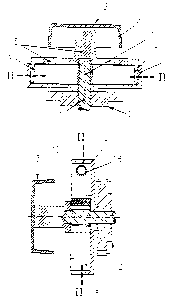Some of the information on this Web page has been provided by external sources. The Government of Canada is not responsible for the accuracy, reliability or currency of the information supplied by external sources. Users wishing to rely upon this information should consult directly with the source of the information. Content provided by external sources is not subject to official languages, privacy and accessibility requirements.
Any discrepancies in the text and image of the Claims and Abstract are due to differing posting times. Text of the Claims and Abstract are posted:
| (12) Patent Application: | (11) CA 2368170 |
|---|---|
| (54) English Title: | ADJUSTING DEVICE |
| (54) French Title: | DISPOSITIF DE REGLAGE |
| Status: | Deemed Abandoned and Beyond the Period of Reinstatement - Pending Response to Notice of Disregarded Communication |
| (51) International Patent Classification (IPC): |
|
|---|---|
| (72) Inventors : |
|
| (73) Owners : |
|
| (71) Applicants : |
|
| (74) Agent: | RICHES, MCKENZIE & HERBERT LLP |
| (74) Associate agent: | |
| (45) Issued: | |
| (86) PCT Filing Date: | 2000-04-03 |
| (87) Open to Public Inspection: | 2000-10-12 |
| Examination requested: | 2002-04-04 |
| Availability of licence: | N/A |
| Dedicated to the Public: | N/A |
| (25) Language of filing: | English |
| Patent Cooperation Treaty (PCT): | Yes |
|---|---|
| (86) PCT Filing Number: | PCT/EP2000/002956 |
| (87) International Publication Number: | WO 2000059753 |
| (85) National Entry: | 2001-09-28 |
| (30) Application Priority Data: | ||||||
|---|---|---|---|---|---|---|
|
The invention relates to an adjusting device for an adjusting element (2)
which is mounted on an axle (1) and by means of a drive mechanism (3) can be
freely turned in both directions of rotation and blocked in each adjusted
position. The device comprises two jaws (8, 8') which by means of the drive
mechanism can together be moved in a housing (7) and at at least one end (15,
15') are each in zero-play contact with an arm (14, 14') of a scissors-type
system (12). The counter-arms (11, 11') of the scissors-type system are in
zero-play contact with a driven element (10) which is rotationally mounted and
connected to the adjusting element.
Dispositif de réglage pour un élément de réglage (2), placé sur un axe (1), qui peut être tourné à volonté dans les deux sens de rotation à l'aide d'un élément de commande (3) et qui peut être bloqué dans chaque position de réglage. Ledit dispositif possède deux mâchoires (8, 8') mobiles ensemble dans un boîtier (7) sous l'effet de l'élément de commande. Lesdites mâchoires sont en contact serré au niveau d'au moins une extrémité (15, 15') avec une branche (14, 14') d'un élément ciseaux (12), les contre-branches (11, 11') de l'élément ciseaux se trouvant en contact serré avec un élément entraîné (10) monté rotatif et relié à l'élément de réglage.
Note: Claims are shown in the official language in which they were submitted.
Note: Descriptions are shown in the official language in which they were submitted.

2024-08-01:As part of the Next Generation Patents (NGP) transition, the Canadian Patents Database (CPD) now contains a more detailed Event History, which replicates the Event Log of our new back-office solution.
Please note that "Inactive:" events refers to events no longer in use in our new back-office solution.
For a clearer understanding of the status of the application/patent presented on this page, the site Disclaimer , as well as the definitions for Patent , Event History , Maintenance Fee and Payment History should be consulted.
| Description | Date |
|---|---|
| Inactive: IPC deactivated | 2019-01-19 |
| Inactive: First IPC from PCS | 2018-01-27 |
| Inactive: IPC from PCS | 2018-01-27 |
| Inactive: IPC expired | 2018-01-01 |
| Inactive: IPC from MCD | 2006-03-12 |
| Inactive: IPC from MCD | 2006-03-12 |
| Application Not Reinstated by Deadline | 2004-04-05 |
| Time Limit for Reversal Expired | 2004-04-05 |
| Amendment Received - Voluntary Amendment | 2003-04-22 |
| Deemed Abandoned - Failure to Respond to Maintenance Fee Notice | 2003-04-03 |
| Letter Sent | 2002-05-30 |
| Inactive: Acknowledgment of national entry - RFE | 2002-05-29 |
| Letter Sent | 2002-05-15 |
| Inactive: Single transfer | 2002-04-10 |
| Request for Examination Requirements Determined Compliant | 2002-04-04 |
| All Requirements for Examination Determined Compliant | 2002-04-04 |
| Request for Examination Received | 2002-04-04 |
| Inactive: Cover page published | 2002-03-14 |
| Inactive: Courtesy letter - Evidence | 2002-03-12 |
| Inactive: Notice - National entry - No RFE | 2002-03-11 |
| Inactive: Filing certificate correction | 2002-03-04 |
| Filing Requirements Determined Compliant | 2002-03-04 |
| Application Received - PCT | 2002-02-15 |
| Inactive: Correspondence - Formalities | 2001-10-11 |
| Application Published (Open to Public Inspection) | 2000-10-12 |
| Abandonment Date | Reason | Reinstatement Date |
|---|---|---|
| 2003-04-03 |
The last payment was received on 2001-09-28
Note : If the full payment has not been received on or before the date indicated, a further fee may be required which may be one of the following
Please refer to the CIPO Patent Fees web page to see all current fee amounts.
| Fee Type | Anniversary Year | Due Date | Paid Date |
|---|---|---|---|
| Registration of a document | 2001-09-28 | ||
| Basic national fee - standard | 2001-09-28 | ||
| MF (application, 2nd anniv.) - standard | 02 | 2002-04-03 | 2001-09-28 |
| Request for examination - standard | 2002-04-04 |
Note: Records showing the ownership history in alphabetical order.
| Current Owners on Record |
|---|
| SCHUKRA-GERATEBAU AG |
| Past Owners on Record |
|---|
| KNUD KLINGER |